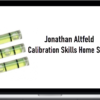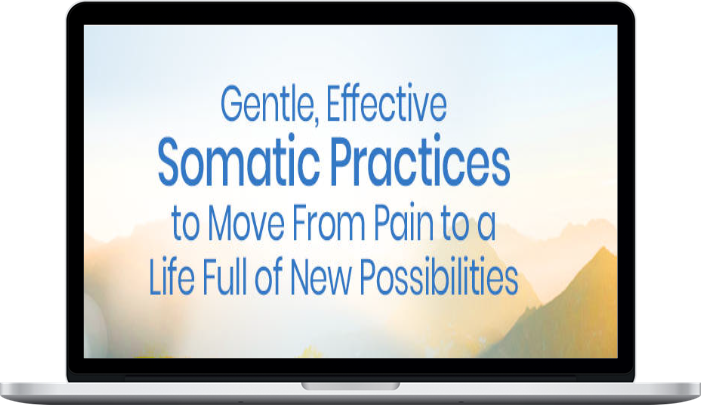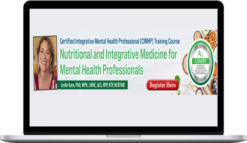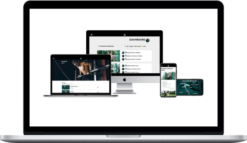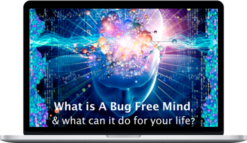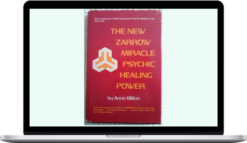Martha Peterson – Gentle, Effective Somatic Practices to Move From Pain to a Life Full of New Possibilities
$297.00 $72.00
»Instant Delivery
Description
Martha Peterson – Gentle, Effective Somatic Practices to Move From Pain to a Life Full of New Possibilities
What you’ll learn in Gentle, Effective Somatic Practices to Move From Pain to a Life Full of New Possibilities
During this Gentle, Effective Somatic Practices to Move From Pain to a Life Full of New Possibilities Course with somatic movement practices, you’ll discover:
- Somatic movement techniques in every session that restore your freedom of movement in your ribs, hips, and shoulders, and in the back, front, and sides of your body… by reconnecting your mind with your body
- How to perceive aging, not by the number of years you’ve lived, but by how you’ve habituated to the challenges in your life — through 3 different stress reflex patterns
- How the technique of pandiculation can improve your sensory motor system, calm your nervous system, and sustainably control your muscles
- How to regain balance, improve breathing, have better posture, and enjoy comfort in everything you do
- How Sensory Motor Amnesia is the root cause of most muscle pain
- New ways to uncover unconscious patterns by exploring how you stand, walk, and sit… and become aware of how connected you are as a somatic system
- A variety of self-sensing exercises that release tension in specific areas of your body
- How to correct imbalances in your body due to physical trauma or one-sided activities that have led to unhealthy habituated movements
- Simple and safe somatic movement techniques that “unstick” your body from harmful repetitive movements
- How to create a daily practice with small movements you can do anytime, anywhere
- What’s possible for your future once you can move with more ease
- And much more…
What You’ll Discover in the Gentle, Effective Somatic Practices to Move From Pain to a Life Full of New Possibilities Course
In Gentle, Effective Somatic Practices to Move From Pain to a Life Full of New Possibilities Course, Martha will guide you through the fundamental insights and movement practices you’ll need to reverse the feelings of “getting old,” greatly reduce pain, and cultivate more ease and mobility… so you can enjoy a self-actualized, deeply fulfilling life.
Gentle, Effective Somatic Practices to Move From Pain to a Life Full of New Possibilities Course will feature step-by-step teachings and experiential practices with Martha. Each session will build harmoniously upon the previous ones, so you’ll develop a complete holistic understanding of the practices, tools, and principles you’ll need to reverse the feeling of “getting old” through a variety of gentle yet powerful movements that can greatly reduce pain and provide more ease and mobility… so you can fully thrive.
Module 1: Release the Habituated Posture of Go-Go-Go! — Addressing Tight Back Muscles

Do you feel stuck in a pattern of “running from” life? Or slumped inward, defeated by life? Maybe you feel that the various aspects of your life are out of balance… and your movement doesn’t reflect the freedom you yearn for.
Life is a complex combination of stressors — some considered “good,” like running, moving, creating… and some “bad,” such as grief, loss, worry, or failure.
In this opening module, you’ll start to explore aging and how it affects the way you can move and feel… perceiving it not by the number of years you’ve lived, but how you’ve habituated to the stresses in your life.
Martha will guide you to experience what these reflexes are and how to begin to release them so that you can take back voluntary control of the unconscious and involuntary reactions and habits that have become stuck in your brain, nervous system, and life.
In this session, you’ll:
- Explore the technique of pandiculation to improve your sensory motor system, calm your nervous system, and improve your ability to control your muscles
- Experience a new way to uncover unconscious patterns by exploring how you stand, walk, and sit. .. and become aware of how connected you are as a somatic system
- Practice 3 simple and safe somatic movements — “Arch and Flatten,” “Back Lift,” and “Diagonal Arch and Curl,” as well as a short seated exploration that will begin to bring the front and back of your body into improved coordination and balance
- Explore the “call to action” and “withdrawal” reflexes (or green light and red light reflexes), to reduce tension between the front and back of your body for more freedom in your spine
- Discover the difference between a body and a soma and how your physical and muscular systems respond to everything you experience in life — creating either tension or ease
- Learn how your habitual responses to stress can contribute to chronic muscle tension (Sensory Motor Amnesia, aka SMA), and how it presents in 3 universal patterns of muscular holding (or stress reflexes)
Module 2: Release the Habituated Posture of Fear & Anxiety — Addressing Tension in the Front of Your Body

Emotional stress and fear can evoke a deeply primal reflex that causes us to withdraw — physically, mentally, and emotionally.
When we respond to this reflex, known as the “startle response” (or red light reflex), we unconsciously tighten the front of our bodies. Our abdominal muscles tighten, the chest collapses inward, the shoulders hunch, and our head goes forward.
Many people incorrectly assume that this posture naturally results from getting older.
In this module, Martha will show you how to release these contracted muscles to experience improved breathing, more energy, and a calmer nervous system.
You’ll also:
- Deepen your ability to sense how you stand and walk, noticing imbalances or areas of tension
- Practice the “Flower” and “Arch and Curl” — 2 somatic movements that begin to reduce anxiety, improve breathing, and enable taller posture through the front of the body
- Continue to turn your awareness inward to your somatic experience and reflect on how your self-image and posture may be affected by the habituation of this deeply primal reflex of protection
- Review the movements from the previous module and continue to explore them in new and different ways
- Receive a graphic that reflects how SMA develops in the brain and how to use pandiculation to reduce it and restore optimum brain-to-muscle connection
- Begin to learn about the “somatic characteristics” we all share as human somas, which serve as inspiration for continual growth and learning throughout our lives
Module 3: Release the Habituated Posture of Trauma — Restoring Balance Through Your Waist Muscles

Accidents, injuries, surgeries, and many one-side-of-the-body activities — such as tennis or holding a baby on your hip — can lead to an imbalance in that area…
And just one unbalanced area can throw our whole system out of whack — from the way we walk, to the quality of our eyesight, to our ability to twist and rotate. This in turn can lead to further injury and stress in our joints.
In this module, you’ll learn movements to help release tension in the sides of your body, giving you more freedom in your shoulders and hips. .. thereby rediscovering your true sense of balance.
Martha will guide you as you:
- Examine how the events of your life — specifically accidents, injuries, surgeries, or one-sided activities — can affect your ability to find balance in your somatic center
- Continue building your movement practice through 2 new movements — the “Side Bend” and the “Human X”
- Discover how releasing tension in your center leads to releasing tension in your extremities
- Sense where imbalances in your waist and sides are presenting, as you stand, walk, and lie down
- Begin to restore balance for more ease in walking and improved stability and connection to the ground
Module 4: Free Your Ribcage for Happier Hips & Shoulders

Now that you’ve learned to release muscle tension in the front, back, and sides of your body, you’re ready to connect your shoulders and hips through rotation and twisting. The shoulders and hips move best when the rib cage is free to move.
Think about babies as they begin to discover their environment. They first notice their ability to extend and flex (or arch and curl) their spine as they lift their head to look around or play with their toes.
Then they become aware of the sides of their body as they begin to roll over, with their breathing being soft and natural. Once they master that movement, they gain voluntary control over their shoulders and hips… and start to crawl.
In this session, you’ll explore that same progression as you restore the ability to freely move your rib cage, shoulders, and hips in opposite directions. As you do, you’ll be on your way to dancing with liberation!
As people gain more freedom, some may experience emotions they weren’t expecting, such as fear, which may force them to challenge the way they’ve been living their lives… because as we change our movements, we change ourselves as human somas.
You’ll explore how releasing fear of moving, other people’s opinions about you, and your mental expectations can impact your long-term success in moving forward in life.
This session is designed to help you:
- Practice another somatic movement, the “Washrag,” to enhance movement in your shoulders and hips for improved coordination in all your daily activities
- Renew your ability to breathe more freely and easily
- Experience improved rotation and movement through your spine as you learn to connect the movement of your shoulders to the movement of your hips
- Continue to deepen your awareness and skill in restoring true balance in your somatic center
- Begin to consider how your mental expectations and mindset can affect not just your long-term health but also your wellbeing and movement
- Reflect objectively on your own personal history and how it may be showing up in your body and your movement
Module 5: Restore a Balanced Gait — Walking With Ease

Everything you’ve been learning so far in this course has been leading to the restoration of the most important movement in our human vocabulary — walking.
Now that you’ve learned how to release the red light, green light, and trauma reflex muscles (the back, front, and sides of your body), you’re ready to put together the mechanics of free and easy walking. Get ready to swing your hips and glide toward a brighter tomorrow!
In this session, you’ll
- Begin to restore movement in your pelvis as it connects to the soft movement of your back and waist
- Practice powerful walking movements to restore balance
- Play with your renewed ease and coordination in walking
- Experience how freedom in your center leads to improved balance, connection to the ground, and efficiency in walking
- Reflect on what’s possible for your future now that you can move with more ease
Module 6: Relieve Neck & Shoulder Pain With Differentiation

Neurons that fire together wire together. In other words, whatever we do consistently becomes a habit at the level of our brain, nervous system, and movement.
You can, however, teach your brain “new tricks.” When you learn to differentiate your movements, you develop the capacity for more precise and skillful movement patterns.
Differentiation disrupts the habits of our brain as we explore smaller, seemingly unrelated aspects of a movement. When you return to the full movement, you move with more flexibility and ease — without forcing or striving.
In this session, you’ll:
- Practice small and gentle movements to calm your nervous system, which significantly impacts your overall wellbeing
- Experience a powerful somatic movement, the “Seated Twist,” using differentiation to create improvement without straining
- Learn to turn and look behind you without straining, forcing, or pushing your neck or back
- Discover how, when you can differentiate your movements, you start to find more ease in everything you do
Module 7: Integrate Somatic Movements Into Your Life

As the old joke goes, a visitor to New York asks a passing stranger, “How do you get to Carnegie Hall?” The man replies, “Practice, practice, practice.”
It’s sage advice.
The best way to create long-lasting improvement in your relationship with yourself, your body, your movement, and your life is to have a daily practice that supports you in becoming more self-sensing.
As you improve your capacity to sense, you become more self-monitoring. And as you enhance your ability to self-monitor, you become more self-correcting, self-regulating, and, ultimately self-actualizing.
In this closing module, you’ll experience a short seated practice that you can do anytime, anywhere.
You’ll also:
- Learn how easily you can do somatic movements in a chair throughout your day
- Be guided through a seated practice to help you sit with ease and always return to a place of balance and comfort
- Investigate how the way you sit when you work or drive may be based on a habitual response that’s contributing to your physical discomfort
- Understand how everything you learned in this course can be applied to your daily life
About Martha Peterson

Martha Peterson is a Certified Clinical Somatic Educator and leader in the field of Somatic Education. She is the founder and CEO of Essential Somatics® and author of Move Without Pain. Martha heads a growing faculty of Clinical Somatic Educators who present Essential Somatics teacher trainings, retreats, workshops, and seminars around the world. She maintains a private clinical practice in Manitou Springs, Colorado.
Martha’s expertise comes from more than 30 years of working in the field of dance, bodywork, and Somatic Education. As a former professional dancer who suffered chronic hip and knee pain due to injuries, Martha understands the frustration and struggle many people experience trying to discern between the myriad different methods that claim to relieve or “fix” chronic pain. This is how she discovered Clinical Somatic Education, the only method that taught her how to reverse her pain and postural imbalances, regain physical control, and create a life of movement, choice, and joy.
Martha is an experienced hiker, inspired by her mother with whom she climbed Mt. Kilimanjaro and trekked in Sikkim, Northern India. She has learned that the key to remaining healthy and mobile is daily, vigorous, fun movement, a regular Somatic Movement routine, a sense of humor, and learning the fine art of relaxation.
More courses from the same author: Martha Peterson
Delivery Policy
When will I receive my course?
You will receive a link to download your course immediately or within 1 to 21 days. It depends on the product you buy, so please read the short description of the product carefully before making a purchase.
How is my course delivered?
We share courses through Google Drive, so once your order is complete, you'll receive an invitation to view the course in your email.
To avoid any delay in delivery, please provide a Google mail and enter your email address correctly in the Checkout Page.
In case you submit a wrong email address, please contact us to resend the course to the correct email.
How do I check status of my order?
Please log in to HealingCourse account then go to Order Page. You will find all your orders includes number, date, status and total price.
If the status is Processing: Your course is being uploaded. Please be patient and wait for us to complete your order. If your order has multiple courses and one of them has not been updated with the download link, the status of the order is also Processing.
If the status is Completed: Your course is ready for immediate download. Click "VIEW" to view details and download the course.
Where can I find my course?
Once your order is complete, a link to download the course will automatically be sent to your email.
You can also get the download link by logging into your HealingCourse account then going to Downloads Page.
Related products
Total sold: 2
Total sold: 3
Total sold: 3
Total sold: 2
Total sold: 3

